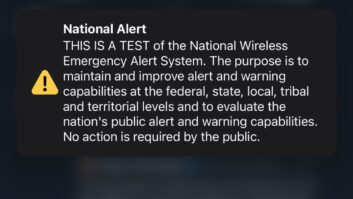When a tower failed in Dickinson, N.D., taking two FM station signals with it, Clear Channel engineers responded quickly, with the help of emergency gear that was standing by in Tulsa, Okla., for such a contingency.
Erik Kuhlmann, Clear Channel’s senior VP of engineering for the Northwest Region, gave an account of how the company responded. It was shared with Radio World by his boss Steve Davis, who has publicly advocated for broadcasters being prepared for the unexpected and has led an effort at Clear Channel to keep equipment scattered around “hubs” in the United States.
The guyed tower serving KZRX and KCAD failed catastrophically around 10 p.m. local time on Wednesday June 1. “One outer guy anchor was carried away in a landslide, which pulled the top half of the tower too far off plumb, resulting in total collapse of the tower,” Kuhlmann wrote.
He was in Anchorage, Alaska, working on an AM diplex at the time. “I was called by the local engineer, Ernie Swanson, moments later. I called Sioux Falls Tower & Communications and left a message to call me ASAP. I contacted Bext and left a message requesting an immediate callback to see how quickly they could ship low-power antennas. I booked a flight out the next morning.”

On Thursday Steve Davis, the company’s senior VP of engineering and capital management, based in Tulsa, asked Steve George to join the recovery efforts; they met on site at 7 p.m. local time. (Coming from Alaska, it had taken Kuhlmann the better part of a day to get to North Dakota. Steve George flew in from Milwaukee to Bismarck.)
“Steve had an hour lead on my arrival and had already begun cobbling together an old antenna found inside the building,” Kuhlmann continued. “The old standby antenna coax somehow escaped major damage, so it was used as a temporary feed from the KZRX auxiliary transmitter. A couple of 2-by-4’s nailed to an old satellite mount provided adequate support for the antenna.
“By roughly 8 p.m. we had KZRX back on the air at a few hundred watts.”

Kuhlmann said Sioux Falls Tower arrived on site at 8 p.m. and was put to work clearing the tower from the building roof.
“More searching for parts and pieces turned up another old KZRX antenna bay. After some tweaking we were able to get the antenna to work on KCAD’s frequency. Since the main transmitter was damaged from having the main antenna coax ripped out of the wall, we decided to retune and use the KZRX main transmitter. The coax for it had also been ripped out of the wall, but not before it ‘drug’ the Z5 [transmitter] across the floor to the wall, so first we had to work it back into position, not an easy task!
“Once retuned, we shoved the make-shift antenna out of the wall and turned it on at a few hundred watts.”

Kuhlmann said KZRX has a telephone loop for an STL that was fully functional, but KCAD used a 950 microwave.
“Since the antenna and line on the old tower were destroyed, we had to find a way to receive the STL. After attempting to build an antenna from parts, we decided to take a quick drive to the studios, where we found a six-foot grid dish outside — amazing luck! Using an extension cord, I strapped the dish to the top of my car and headed back to the site. Using another abandoned satellite dish mount, we were able to attach the six-foot dish, and using some coax stored inside the garage, we finally had audio. KCAD returned to the air at roughly midnight.”

Come Friday, Kuhlmann spent the morning repairing the KCAD main transmitter.
Meanwhile, Clear Channel engineering exec Allan Brace had been driving 1,100 miles from Tulsa with the company’s “Tower on Wheels,” part of its Disaster Assistance and Response Plan gear inventory, along with FM and STL antennas, coax and RF adaptors/connectors. CC keeps transmitter trucks and other gear in eight hub locations, though this is the only portable tower in the fleet.

Brace, George and Kuhlmann assembled the two-bay vertical antenna and bolted it to the top of the portable tower.
“Due to 50+ mph winds, we opted not to extend the tower to its maximum height. By 5 p.m. we had KCAD operating at roughly 10 kW ERP. At just 30 feet off the ground, the station can be heard 50 miles away — so, a good interim fix.”
On Saturday, Kuhlmann instructed Sioux Falls Tower to cut a section of usable tower from what was left of the original and stand it up next to the building to support the second two-bay antenna from Tulsa for KZRX. Soon KZRX was operating at roughly 10 kW, “near its licensed power of 10.5 kW, albeit from slightly less elevation. A geotechnical survey will be conducted ASAP to prepare for construction of the new replacement tower.”

He said a new tower is planned and the two FMs will be combined into a new ERI antenna.
Structural design work for that is complete, and the antenna is expected within six weeks.
Share your own stories about solving engineering problems. E-mail me at [email protected].
— Paul McLane
Related:
“Stay on in Snow, Rain or Gloom of Night” (2009)












